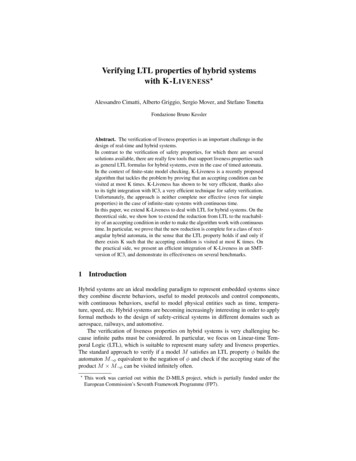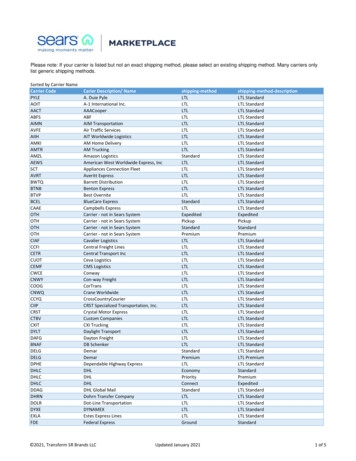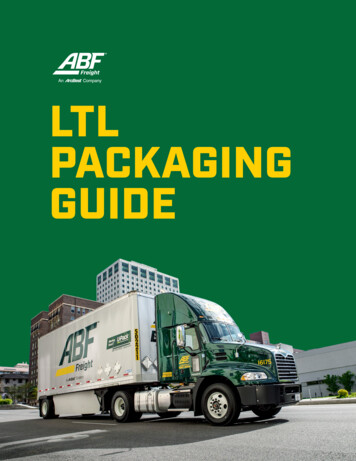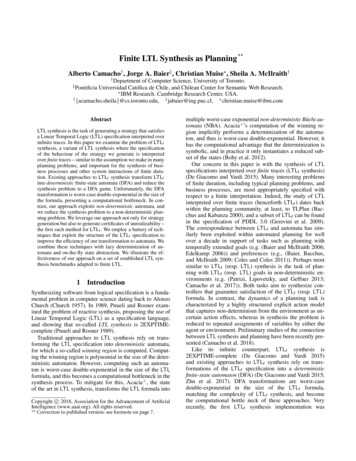
Transcription
Verifying LTL properties of hybrid systemswith K-L IVENESS?Alessandro Cimatti, Alberto Griggio, Sergio Mover, and Stefano TonettaFondazione Bruno KesslerAbstract. The verification of liveness properties is an important challenge in thedesign of real-time and hybrid systems.In contrast to the verification of safety properties, for which there are severalsolutions available, there are really few tools that support liveness properties suchas general LTL formulas for hybrid systems, even in the case of timed automata.In the context of finite-state model checking, K-Liveness is a recently proposedalgorithm that tackles the problem by proving that an accepting condition can bevisited at most K times. K-Liveness has shown to be very efficient, thanks alsoto its tight integration with IC3, a very efficient technique for safety verification.Unfortunately, the approach is neither complete nor effective (even for simpleproperties) in the case of infinite-state systems with continuous time.In this paper, we extend K-Liveness to deal with LTL for hybrid systems. On thetheoretical side, we show how to extend the reduction from LTL to the reachability of an accepting condition in order to make the algorithm work with continuoustime. In particular, we prove that the new reduction is complete for a class of rectangular hybrid automata, in the sense that the LTL property holds if and only ifthere exists K such that the accepting condition is visited at most K times. Onthe practical side, we present an efficient integration of K-Liveness in an SMTversion of IC3, and demonstrate its effectiveness on several benchmarks.1IntroductionHybrid systems are an ideal modeling paradigm to represent embedded systems sincethey combine discrete behaviors, useful to model protocols and control components,with continuous behaviors, useful to model physical entities such as time, temperature, speed, etc. Hybrid systems are becoming increasingly interesting in order to applyformal methods to the design of safety-critical systems in different domains such asaerospace, railways, and automotive.The verification of liveness properties on hybrid systems is very challenging because infinite paths must be considered. In particular, we focus on Linear-time Temporal Logic (LTL), which is suitable to represent many safety and liveness properties.The standard approach to verify if a model M satisfies an LTL property φ builds theautomaton M φ equivalent to the negation of φ and check if the accepting state of theproduct M M φ can be visited infinitely often.?This work was carried out within the D-MILS project, which is partially funded under theEuropean Commission’s Seventh Framework Programme (FP7).
In the context of finite-state model checking, many efficient algorithms reduce liveness properties to one or more safety properties. For example, K-L IVENESS is a recently proposed technique that proves that the accepting state is visited finitely manytimes by checking that it is visited at most K times for increasing values of K. Thelatter can be easily reduced to a reachability problem. K-Liveness has shown to be veryefficient, thanks also to its tight integration with IC3, probably the current most effective technique for safety verification. Unfortunately, the approach is neither completenor effective (even for simple properties) in the case of infinite-state systems with continuous time.The main problem of techniques based on the reduction to safety is that they relyfor soundness or completeness on the existence of a lasso-shape counterexample, butin the case of infinite-state systems such as hybrid systems, there may be infinite tracesthat do not correspond to any lasso-shape fair path. Moreover, the model may includeZeno paths where time converges, which must be excluded when checking the livenessproperties. Techniques based on abstraction refinement can prove that a property holds,but in general the refinement is not guaranteed to converge.In this paper, we provide a new method that, by forcing the progress of time beyondsymbolic bounds, links the number of iterations of K-L IVENESS to the time elapsedin the counterexamples, rather than to the number of transitions. We prove that the reduction is complete for initialized Rectangular Hybrid Automata (RHA) with boundednon-determinism even in the presence of parameters. We implemented the techniqueson top of H Y C OMP [1], a tool for the verification of hybrid systems. The verificationof reachability is based on an SMT version of IC3 that integrates predicate abstractionin an efficient way. An experimental evaluation demonstrates the efficiency of the approach on several benchmarks. To the best of our knowledge, this is the first effectivetool that verifies general LTL properties on Hybrid Automata.The paper is organized as follows: Section 2 presents some basic notations on RHA,LTL, and SMT-based techniques to verify hybrid systems; we also give a brief overviewof IC3 and K-L IVENESS; in Section 3, we present the new approach to the LTL verification of hybrid systems; in Section 4, we overview the related work; in Section 5, wedescribe the implementation, the experimental evaluation, and we present the results;finally, in Section 6 we draw some conclusions and discuss future directions.22.1BackgroundHybrid and Timed AutomataHybrid systems have a discrete part, which ranges over the nodes of a graph, and acontinuous part, which ranges over an Euclidian space Rn . Although the approach presented in this paper can be applied to any hybrid system that can be encoded into asymbolic transition system, the theoretical results are restricted to the parametric version of Rectangular Hybrid Automata [2]. A Parametric Rectangular Hybrid Automaton(PRHA) is a tuple H hP, Q, Q0 , E, X, flow, init, inv, jump, guard, updatei where:– P is a finite set of parameters,– Q is the (possibly infinite) set of locations,
– Q0 Q is the (possibly infinite) set of initial locations,– E Q Q is the (possibly infinite) set of discrete transitions,– X is the finite set of continuous variables,– flow : Q X R is the flow function,– init : Q X R(P ) is the initial function,– inv : Q X R(P ) is the invariant function,– jump : E 2X is the jump function,– guard : E X R(P ) is the guard function,– update : E X R(P ) is the update function,where R is the set of (possibly unbounded) real intervals and R(P ) represents the setof parametric intervals, whose endpoints are either a constant, or , or a parameterin P (e,g., [0, 0], (1, ), ( , p]). We can see parametric intervals as function froman evaluation of the parameters to the intervals of R. So, if c is an assignment to theparameters in P and I R(P ), then I(c) is a real interval.A Rectangular Hybrid Automaton (RHA) is simply a PRHA with P . A (Parametric) Timed Automaton (TA) is an RHA (resp. PHRA) such that, for all q Q, forall x X, flow(q)(x) [1, 1], init(q)(x) [0, 0], and for all e E, for all x X,update(e)(x) [0, 0]. A (P)RHA H is initialized iff for every edge hq, q 0 i E, forall x X, if flow(q)(x) 6 flow(q 0 )(x), then x jump(hq, q 0 i). H has bounded nondeterminism iff for all x X, for all q Q, for all e E, init(q)(x), flow(q)(x), andupdate(e)(x) are bounded.As in [3], we use a variable pc 6 X P as a control variable that ranges over the setQ of locations (properly encoded in R). Moreover, we use a variable time to representthe elapsing time and let VH {time, pc} P X. A state is an assignment to VH ,i.e., a function VH R. We can see a state also as a tuple hq, s, c, ti where q Q, s isan assignment to X, c is an assignment to P , and t is an assignment to time. A path ofa PRHA H is a sequence of states hq0 , s0 , c0 , t0 i, hq1 , s1 , c1 , t1 i, . . . such that:– for all i, j 0, ci cj c, for some c;– t0 0 and for all i 0, ti ti 1 ; let δi ti 1 ti ;i (x) – for all i 0, if δi 0, then qi 1 qi and, for all x X, si 1 (x) sδiflow(qi )(x) (note that, in more general classes of hybrid automata, this would require a condition on all time points);– q0 Q0 and, for all x X, s0 (x) init(q0 )(x)(c);– for all i 0, if δi 0, then hqi , qi 1 i E, for all x 6 jump(hqi , qi 1 i), si 1 (x) si (x); for all x X, si (x) guard(hqi , qi 1 i)(x)(c); for all x jump(hqi , qi 1 i), si 1 (x) update(hqi , qi 1 i)(x)(c);– for all i 0, for all x X, si (x) inv(qi )(x)(c).Given a sequence of states σ σ0 , σ1 , . . ., we denote with σ[i] the i 1-th state σiand with σ i the suffix sequence starting from the σ[i].A path whose sequence t0 , t1 , . . . of time points does not diverge is called Zenopath (non-Zeno otherwise). A state s is Zeno or time-locking iff there is no non-Zenopath starting from s. A state s is reachable iff there exists a non-Zeno path σ such thatσ[i] s for some i 0.
2.2LTLWe use Linear-time Temporal Logic (LTL) [4] to specify properties on a PRHA H.The atomic formulas Atoms are predicates over the variables VH . Besides the Booleanconnectives, LTL uses the temporal operators X (“next”) and U (“until”). Formally,– a predicate a Atoms is an LTL formula,– if φ1 and φ2 are LTL formulas, then φ1 , and φ1 φ2 are LTL formulas,– if φ1 and φ2 are LTL formulas, then Xφ1 and φ1 Uφ2 are LTL formulas.We use the standard abbreviations: : p p, : p p, Fφ : Uφ,Gφ : F φ, and φ1 Rφ2 : ( φ1 U φ2 ).Given an LTL formula φ and a sequence σ of states of H, we define σ φ, i.e.,that the path σ satisfies the formula φ, as follows:– σ a iff σ[0] a– σ φ ψ iff σ φ and σ ψ– σ φ iff σ 6 φ– σ Xφ iff σ 1 φj– σ φUψ iff for some j 0, σ ψ and for all 0 k j, σ k φ.Given a PRHA H and an LTL formula φ over VH , we focus on the model checkingproblem of finding if, for all non-Zeno paths σ of H, σ φ.Note that, although the predicates can contain references to the time variable, thelogic is interpreted over discrete sequences of states.The problem is in general undecidable for PRHA and decidable for some fragmentssuch as initialized RHA with bounded non-determinism [2].2.3Transition SystemsA transition system M is a tuple M hV, I, T i where V is a set of (state) variables,I(V ) is a formula representing the initial states, and T (V, V 0 ) is a formula representingthe transitions. In this paper, we shall deal with linear rational arithmetic formulas,that is, Boolean combinations of propositional variables and linear inequalities overrational variables. A state of M is an assignment to the variables V . We denote withΣV the set of states. A [finite] path of M is an infinite sequence s0 , s1 , . . . [resp., finitesequence s0 , s1 , . . . , sk ] of states such that s0 I and, for all i 0 [resp., 0 i k],si , s0i 1 T . Given two transitions systems M1 hV1 , I1 , T1 i and M2 hV2 , I2 , T2 i,we denote with M1 M2 the synchronous product hV1 V2 , I1 I2 , T1 T2 i.Given a Boolean combination φ of predicates, the invariant model checking problem, denoted with M f in φ, is the problem to check if, for all finite paths s0 , s1 , . . . , skof M , for all i, 0 i k, si φ.Given a LTL formula φ, the LTL model checking problem, denoted with M φ,is the problem to check if, for all (infinite) paths σ of M , σ φ.The automata-based approach [5] to LTL model checking is to build a transitionsystem M φ with a fairness condition f φ such that M φ iff M M φ FG f φ .This reduces to finding a counterexample as a fair path, i.e., a path of the system thatvisits the fairness condition f φ infinitely many times. In case of finite-state systems,if the property fails there is always a counterexample in a lasso-shape, i.e., formed by aprefix and a loop.
2.4SMT-based Verification of Reachability for PRHAGiven a PRHA H, we encode H into a transition system MH in order to apply SMTbased verification techniques for infinite-state systems. Such kind of encoding has beenwidely used in the literature (e.g., [6, 7]). MH hVH , IH , TH i is defined as follows:VVdef– IH (time 0) q Q x X x init(q)(x) x inv(q)(x).VVdef– TH (T IMED U NTIMED) q Q inv(q)(X) inv(q)(X 0 ) p P p0 p, wheredefU NTIMED defVq pc q 0 ) x X guard(q)(x) hq,q 0 i E (pc V00x6 jump(hq,q 0 i) x x x jump(hq,q 0 i) x update(q)(x)VV 0 pc0 pc q Q x X (pc q (x0 x) δ · flow(q)(x))δ 0 VT IMED δdef0δ time time.VThere is a one-to-one mapping between the states of H and those of MH , and alsobetween the paths of H and those of MH . We say that a path of MH is Zeno [non-Zeno]iff the sequence of assignments to time does not diverge [resp., diverges].Given a PRHA H, assuming that H does not have Zeno states, a state s is reachablein H iff MH 6 f in s (where s is seen as a formula).2.5IC3 and K-L IVENESSSAT-based algorithms take in input a propositional (with Boolean variables) transitionsystem and a property, and try to solve the verification problem with a series of satisfiability queries. These algorithms can be naturally lifted to SMT in order to tackle theverification of infinite-state systems.IC3 [8] is a SAT-based algorithm for the verification of invariant properties oftransition systems. It builds an over-approximation of the reachable state space, usingclauses obtained by generalization while disproving candidate counterexamples.We recently presented in [9] a novel approach to lift IC3 to the SMT case, whichis able to deal with infinite-state systems by means of a tight integration with predicateabstraction (PA) [10]. The approach leverages Implicit Abstraction (IA) [11], whichallows to express abstract transitions without computing explicitly the abstract system,and is fully incremental with respect to the addition of new predicates.In this paper, we focus on K-L IVENESS [12], an algorithm recently proposed toreduce liveness (and so also LTL verification) to a sequence of invariant checking. Differently from other reductions (such as [13]), it lifts naturally to infinite-state systemswithout requiring counterexamples to be in a lasso-shape form. K-L IVENESS uses astandard approach to reduce LTL verification for proving that a certain signal f is eventually never visited (FG f ). The key insight of K-L IVENESS is that, for finite-statesystems, this is equivalent to find a K such that f is visited at most K times, which inturn can be reduced to invariant checking.Given a transition system M , a Boolean combination of predicates φ, and a positiveinteger K, for every finite path σ of M , let σ f in ](φ) K iff the size of the set{i σ[i] φ} is less or equal to K. In [12], it is proved that, for finite-state systems,M FG f iff there exists K such that M f in ](f ) K. The last check can bereduced to an invariant checking problem. K-L IVENESS is therefore a simple loop thatincreases K at every iteration and calls a subroutine S AFE to check the invariant. In
particular, the implementation in [12] uses IC3 as S AFE and exploits the incrementalityof IC3 to solve the sequence of invariant problems in an efficient way.33.1SMT-Based Verification of LTL for PRHAK-L IVENESS for Hybrid AutomataK-L IVENESS is not complete for infinite-state systems, because even if the propertyholds, the system may visit the fairness condition an unbounded number of times. Consider for example a system with an integer counter and a parameter p such that thecounter is used to count the number of times the condition f is visited and once thecounter reaches the value of p, the condition is no more visited. This system satisfiesFG f because for any value of p, f is visited at most p times. However, K-L IVENESSwill obtain a counterexample to the safety property ](f ) K for every K, by setting pto K.Similarly, K-L IVENESS does not work on the transition system representing a TA.In particular, a fair Zeno path forbids K-L IVENESS to prove the property: for every K,the fairness is visited more than K times, but in a finite amount of (real) time. RemovingZeno paths by adding an automaton to force progress is not sufficient for PTA and ingeneral hybrid systems. In fact, in these systems a finite amount of time can be boundedby a parameter or a variable that is dynamically set. Therefore, in some cases, there isno K to bound the occurrences of the fairness, although there is no fair non-Zeno path.In the following, we show how we make K-L IVENESS work on hybrid automata.The goal is to provide a method so that K-L IVENESS checks if there is a bound on thenumber of times the fairness is visited along a diverging sequence of time points. Theessential point is to use a symbolic expression β based on the automaton structure toforce a minimum distance between two fair time points. We use an additional transitionsystem Zβ , with a condition fZ , to reduce the problem of proving that H φ toproving that MH M φ Zβ FG fZ . In Section 3.2, we prove that the twoproblems are equivalent for any positive β. In Section 3.3, we define β so that KL IVENESS is not deemed to diverge and, on the contrary, must converge for some classof automata.3.2Linking the fairness to time progressIn this section, we define the transition system Zβ that is later used to make K-L IVENESSconverge. We first define a simpler version ZB that works only for timed automata.Consider the fair transition system M MH M φ resulting from the productof the encoding of an PRHA H and of the negation of the property φ. Let f be thefairness condition of M . We build a new transition system ZB (f, time) that filters theoccurrences of f along a time sequence where time values are distant more than Btime units. ZB (f, time) is depicted in Figure 1. It has two locations (represented bya Boolean variable l) and a local real variable t0 . The initial condition is l 0. Thefairness condition fZ is l 1. The system moves or remains in l 0 keeping t0unchanged. It moves or remains in l 1 if f is true and time t0 B and sets t0 totime.
f time t0 Bt00 timet0 0l 0l 1t00 timet00 timef time t0 Bt00 timeFig. 1. Monitor ZB (f, time).f time t0 β(x0 )t00 time x00 xt0 0l 0l 1t00 t0 , X00 X0t00 t0 , X00 X0f time t0 β(x0 )t00 time x00 xFig. 2. Monitor Zβ (f, time, X).We reduce the problem of checking whether φ holds in H to checking that thefairness condition fZ cannot be true infinitely often in MH M φ ZB , i.e. MH M φ ZB FG fZ .Theorem 1. If B 0, H φ iff MH M φ ZB FG fZ .Proof. If there exists a non-Zeno path π of MH that violates φ, then there exists a fairpath π 0 of M φ so that π π 0 is a fair non-Zeno path of M M φ . We can build amatching path πZ of ZB . In fact, if the path πZ [i] is in l 0, there are infinitely manyj i such that π 0 (j) f φ and we can pick one moving to l 1 with time(j) time(i) B since π is non-Zeno.If a path π of M M φ ZB visits fZ infinitely often, then for infinitely manypoints i 0, π i f φ and there exists j i such that π j f φ time t0 B. Therefore the projection of π over MH corresponds to a fair non-Zeno path of Hviolating φ.tuWe generalize the construction of ZB considering as bound on time a functionβ over some continuous variables of the model. The new monitor is Zβ (f, time, X)shown in Figure 2. It has a local variable x0 for every variable x occurring in β. X0is the set of such variables. Now, when t0 is set to time, we set also x0 to x and thisvalue is kept until moving to l 1. The condition on time is now time t0 β(X0 ).It is easy to see that we can still prove that if β(X) is always positive, then H φ iffMH M φ Zβ FG fZ .We say that the reduction is complete for K-L IVENESS for a certain class H ofautomata iff for every H H there exists βH such that H φ iff there exists Ksuch that M M φ ZβH f in ](fZ ) K. Thus, if H φ, and the reductionis complete, and the subroutine S AFE terminates at every call, then K-L IVENESS alsoterminates proving the property.3.3The K-Z ENO algorithmThe K-Z ENO algorithm is a simple extension of K-L IVENESS which, given the problemH φ, builds M MH M φ Zβ and calls K-L IVENESS with inputs M and fZ .As K-L IVENESS, either K-Z ENO proves that the property holds or diverges increasingK up to a certain bound. The crucial part is the choice of β, because the completeness of the reduction depends on β. Note that the reduction may be complete, but thecompleteness of K-Z ENO still depends on the completeness of the S AFE algorithm.
b : bAs for TAs, we take as β the maximum among the constants of the model and 1. For example, consider the TAin figure 3 (it is actually a compact representation of theloc1TA where loc1 is split into two locations corresponding toloc2ẋ 1ẋ 1x 1b and b ). It represents an unbounded numberof switches of b within 1 time unit. The model satisfies theproperty FGpc loc2. Taking β 1, K-Z ENO provesFig. 3. Example of TA.the property with K 1. In fact, starting from the location loc1, after 1 time unit, the automaton cannot reach loc1 anymore. For PTAs, weconsider as β the maximum among the parameters, the constants of the model and 1.We generalize the above idea to consider PRHA with bounded non-determinism.We also assume an endpoint of a flow interval is 0, it cannot be open (must me includedin the interval). Guards and invariants of PRHA are conjunctions of inequalities of theform x ./ B where ./ { , , , }. Hereafter, we refer to one of such inequalitiesas a constraint of the PRHA.For every constraint g in the form x B or x B (guard or invariant) of HA,we consider the minimum positive lower bound rg for the derivative of x, if exists. Forexample, if we have three locations with ẋ [1, 2], ẋ [0, 3], ẋ [ 1, 2], we takerg 1 (since 0 and 1 are not positive). We consider the minimum lower bound vg forthe non-deterministic reset of x. For example, if we have three transitions with resetsx0 [1, 2], x0 [0, 3], x0 [ 1, 2], we take vg 1. In case g is in the form x Bor x B, we define rg and vg similarly by considering the maximum negative upperbound of the derivative of x and the maximum upper bound of the reset of x. We definethe bound βg (x0 ) as follows: βg (x0 ) max((B x0 )/rg , (B vg )/rg ).Finally, as β we take the maximum among the βg for all g in the automaton H forwhich rg exists and the constant 1. Note that this coincides with the β defined above forTA and Parametric TA, where rg is always 1 and vg is always 0 and x0 is always nonnegative.3.4Completeness for Rectangular Hybrid AutomataIn this section, we restrict the focus to PRHA that are initialized and have bounded nondeterminism. Moreover, we restrict the LTL formula to have the atoms that predicateover pc only. In this settings, we prove that the reduction to K-L IVENESS defined in theprevious section is complete.Given a PRHA H hP, Q, Q0 , E, X, flow, init, inv, jump, guard, updatei and anLTL formula φ with transition system M φ hV, I, T i and fairness condition f φ , webuild a new PRHA H φ hP, Q0 , Q00 , E 0 , X, flow0 , init0 , inv0 , jump0 , guard0 , update0 iwhere:– Q0 {q s Q ΣV q Q, s q};– Q00 {q s Q0 q Q0 , s I};– E 0 {hq s, q 0 s0 i Q0 Q0 hq, q 0 i E, s, s0 T };– for all q s Q, flow0 (q s) flow(q), init0 (q s) init(q), inv0 (q s) inv(q); for all hq s, q 0 s0 i E 0 , jump0 (hq s, q 0 s0 i) jump(hq, q 0 i),guard0 (hq s, q 0 s0 i) guard(hq, q 0 i), update0 (hq s, q 0 s0 i) update(hq, q 0 i).
It is easy to see that H φ iff H φ FG f φ iff MH φ Zβ FG fZ .In order to prove that the reduction to K-L IVENESS is complete, we prove the following lemma.Lemma 1. Consider an initialized with bounded non-determinism PRHA H. SupposeMH φ Zβ FG fZ . Let KH and NH be respectively the number of edges andlocations of H φ . Then MH φ Zβ f in ](fZ ) (KC · NC ) 1.Proof. We prove the lemma by induction on KH . Suppose KH 0, i.e., there is noedge. Therefore, there cannot be a reset of the variables and, therefore, the time spentalong a path of MH φ Zβ must be less than β(X0 ) where X0 is the initial value ofX. Thus, fZ cannot be visited twice.Suppose KH 1. First, note that, since MH φ Zβ FG fZ , MH φ Zβcannot have fair non-Zeno paths. Therefore, for every fair path σ of MH φ , there mustbe a constraint (or more than one) of H φ that eventually blocks the transition to fZ inZβ . Suppose fZ is visited at least once (although for a finite number of times). Then,there must exist an edge e of H φ that is eventually no more taken along σ. Therefore,σ, after a certain point t, will coincide with a path of MH 0 where MH 0 is the encodingof a PRHA H 0 obtained from H φ by removing e and setting as initial state the statereached by σ at point t. Therefore MH 0 Zβ FG fZ and H 0 has KH 1 edges.Thus, by induction fZ must be visited less or equal than (KH 1) · NH 1 times.Finally we have to show that the number of times fZ is visited before t is lessthan or equal to NH . Suppose by contradiction, fZ is visited NH 1 times. Then,at least one fair location of H φ is repeated so that we have a fair loop in the graphof H φ . Due to the definition of Zβ , for any constraint g in the form x B (andsimilar for the other cases), if x has a positive derivative and is not reset, g must becomefalse between two fair states. Thus, either g is not used along the loop or x is reset orthe derivative may be non positive. Since H is initialized, if the lower bound of thederivative becomes non positive, x must be reset. Therefore, every variable involvedin a constraint along the path must be reset or the derivative can remain non-positivenever violating the constraint. This means that there would be an infinite fair non-Zenoloop, which contradicts the hypothesis. We conclude that the number of times fZ canbe visited along σ is less than (KH 1) · NH 1 NH (KH · NH ) 1.tuTheorem 2. If H φ, then there exists K such that MH M φ Zβ f in ](fZ ) K.Proof. Since there exists a one-to-one mapping between the paths of MH M φ Zβand those of MH φ Zβ , by Lemma 1, MH M φ Zβ f in ](fZ ) (KH ·NH ) 1where KH and NH are respectively the edges and locations of H φ .tuIf the hybrid automaton falls outside of the class of iniy : 0tialized PRHA with bounded non-determinism, K-Z ENObadgoodẋ 1ẋ 0is still sound, but no longer guaranteed to be complete.ẏ 1ẏ 1x 1A simple counterexample is shown in Figure 4, in whichy 0the stopwatch variable x is not reset when its dynamicchanges. The automaton satisfies the property (FGgood),because the invariant on x and the guard on y make sure Fig. 4. Stopwatch automaton
that the total time spent in bad is at most 1 time unit. However, K-Z ENO cannot proveit with any K because time can pass indefinitely in good, while x is stopped. Therefore,it is always possible to visit bad and fZ an unbounded number of times. Finally, notethat K-Z ENO is able to prove other properties such as for example that the stopwatchautomaton satisfies the formula GFgood.4Related WorkThere are many works that focus on the verification of safety properties on hybrid systems [14–19], see [20] for a recent survey. We concentrate on the problem of livenessand deal with a semantics based on infinite paths.The problem of checking time progress is well known and efficient solutions forTAs are based either on transforming the automaton in a strongly non-Zeno automaton [21], forcing the original TA to move to an additional (non-accepting) location incase of Zeno behavior, or on checking if from all reachable states, time can elapse fromthe 1 time unit [22]. In U PPAAL, this is achieved by taking the product of the modelwith a monitor automaton that changes state every c time units (where c is a “constantset to a good value w.r.t. the rest of the model”) [23]. This approach is also used byD I V IN E [24], an explicit-state model checker that is capable of verifying LTL properties over U PPAAL models. The monitors that we use in K-Z ENO can be seen as ageneralization of this approach. As discussed, using a constant is not enough for PTAsand (P)RHAs. Our method uses as bounds for time progress symbolic expressions overvariables that change along a path.A well-known reduction of liveness to safety is presented in [13]. The approachuses copies of the state variables to store the value of a state and search for a fair loop.In [25], the above technique is extended for different kinds of infinite-state systemssuch as pushdown systems and TAs, but each reduction is ad-hoc for the specific classof systems. A similar technique is also used in [26] for hybrid systems. The techniqueis not sound in general for infinite-state systems because there are simple cases wherethere are counterexamples but none of them has a lasso shape. So, it may be possiblethat the invariant holds in the reduced system but the original property does not hold.K-L IVENESS and K-Z ENO are always sound: if the invariant holds for some K, thenthe original property is true.Restricted to timed automata, apart from D I V IN E, the U PPAAL model checker [27]does not support LTL, but a different fragment of temporal properties. However, thisfragment of temporal logic does not consider infinite Zeno paths, but it is based on finitepaths that possibly end in time-locks. A recent approach [28] considers LTL modelchecking for TAs. However, the authors explicitly assume to have TAs without Zenopaths. First, our approach differs since we allow Zeno paths in the model. Then, ourtechnique is more general, since we handle hybrid automata with parameters.With respect to hybrid systems, an interesting liveness property is stability, whichrequires that all the paths of the system eventually stay in a region. The work [29]reduces the verification of stability properties to comput
2.2 LTL We use Linear-time Temporal Logic (LTL) [4] to specify properties on a PRHA H. The atomic formulas Atoms are predicates over the variables V H. Besides the Boolean connectives, LTL uses the temporal operators X ("next") and U ("until"). Formally, - a predicate a2Atoms is an LTL formula, - if 1 and 2 are LTL formulas .










